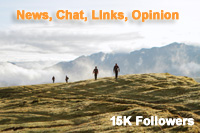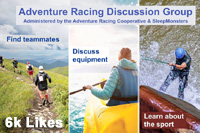Huairasinchi - The 2014 Adventure Racing World Championships
Team Seagate Captain's Report
Nathan Fa'avae / 18.11.2014


When Ecuador was announced as the host country for the 2014 World Championships I have to admit I was not very excited. While the country itself had a lot of appeal as a place to visit, diverse ecology and environments plus an abundance of tropical fruit, the high mountains of Ecuador are a long way above sea level and from my experience, adventure racing and altitude is a bad combination. My team, Seagate (Sophie Hart, Chris Forne, Stuart Lynch), were keen to contest the World Championships so we knew we needed to prepare as best we could.
It was obvious that to be competitive in the race we needed to do some proper acclimatisation. I decided a good plan would be to enlist the expertise of Adventure Consultants in Wanaka NZ, one of the worlds leading Expedition Guiding companies, I spoke to them about what we were preparing for and they got really excited about helping us out. Luckily for us Seagate also understood the importance of traveling to Ecuador early to train in the mountains and they provided additional funding to allow that to happen. By the time the race started, we’d spent the best part of 3-weeks training and living in the mountains around Cotopaxi (5911m), which we also climbed, a major highlight of the trip. It was a big commitment for us to be living in Ecuador for that length of time pre race but we wanted to give ourselves the best chance of winning as we could.
For me personally, I’ve had a difficult year training and racing with regular problems with my heart and the condition I suffer from, atrial fibrillation. In mid July I had my 3rd ablation surgery to my heart and it seems to have worked, but it compromised my ability to properly train for the race, I did what I could, but I knew it was barely enough. That combined with my age it is very humbling racing in such a strong team, it feels to me that my main job is to get the team to the start line, then they get me to the finish line! That said, now that my health is on the improve, I am really eager to end my career with a strong finish so that’ll be my goal for 2015, to try and rediscover the form I once had, or at least part of it.
The World Champs was hosted by a race called the ‘Huairasinchi’, it is a word from the native Kichwa language that means “the strength of the wind”. The race started in 2003 and the Race Directors Santiago López and Rodolfo Peralta have a huge amount of experience and skills. All year leading up to the event I had a good feeling about Team Seagate racing in Ecuador, I thought that’d the Huairasinchi would deliver a worthy World Championship course.
The route passed through three continental regions of Ecuador: coast, highlands, and Amazon, crossing the equator line 0°.
After a few days of pre race proceedings that are generally quite exhausting, we finally boarded buses to the start line on November 9th.
Due to the length of time away from home, Jodie my wife and I decided that we’d make a family trip out of the race so my three children Jessie, Zephyr and Tide came over to follow the race and travel Ecuador, we’re here for 8-weeks total.
Being ranked the number one team in world we did enter the race in most peoples books as pre race favourites, but that does not account for much, at the 2013 World Championships in Costa Rica we were also the pre race favourite (ranked #1 and defending World Champions) but we failed to finish the race due to contracting some tropical foot infections. Prior to withdrawing, we were having an excellent race and had set ourselves up for a very strong finish, but such is racing.
Standing on the start line in Ecuador, we wanted to win, but before we could even dream about winning, we firstly needed to finish. We needed to race like a champion team and hope that would see us cross the finish line first, in front of the other 52-teams from 20-different nations.
Let’s take a trip through Ecuador with Team Seagate …
Stage 1; Mountain Trek (29 km)
Within the Antisana Reserve, the race started at La Mica Lake and ended by Jamanco-Papallacta, starting at an altitude of 4000m in the Antisana Ecological Reserve which is located in the eastern area of the Andes highlands. The start of these races is always crazy with teams taking off like it’s a one hour race, but due to the altitude, I was pleasantly surprised that the pace was quite relaxed. In open landscape teams were able to spread out quickly and I noted that quite a few teams were breathing really hard, I thought to myself a few times how lucky we were to have acclimatised so well. I was feeling good as we climbed to the pass at 4400m, massive views of the Volcano Antisana alongside. Chris was very excited to be underway and burning up his energy.
Despite Sophie going really well, Chris started carrying her pack and later wanted to take gear from my pack. I was feeling fine and happy with the speed but I figured if he was feeling that good then sure, I’d happily travel lighter. In hindsight, I think Chris would have been better to have cruised at our pace. We had 700km to go, we didn’t need to start racing at that point, the highest section of the race. The scenery on this stage was magnificent and made even more rewarding when our team took a shortcut off the trail systems and had a close encounter with a Puma, we got to see the big cat close up for a long period, it was amazing to see such an animal in the wild, it’s behaviour was really interesting as it checked us out, it showed no sign of fear, I guess it knew that it could either out run us or tear us to shreds depending on how it felt.
By the end of the stage about 5-of the top teams were all together. We’d spent a lot of stage with our friends from Sweden, team Silva Haglöfs, which is captained by Kiwi Aaron Prince, we viewed this team as the strongest competitor in the field, along with team Columbia Vidaraid (Spain, Brazil, USA) and Team France (two of the members won in Costa Rica in 2013)
We ended the stage in good shape but Chris reported he wasn’t feeling great.
Stage 2; Mountain Bike (67 km)
This was a welcome stage to have after the high mountain pass, from Jamanco to El Chaco we descended an incredible 1800-metres on bikes following roads along the edge of rivers that eventually wind their way down to feed the Amazon River. We were in 2nd place and happily riding down into the thicker and warmer air. It was amazing how much difference the denser more oxygenated air made when working hard, for the first time in weeks we felt normal. Chris clearly wasn’t in good shape and we got passed by a few teams but his superior navigation got us back into 2nd by the end of the stage.
Stage 3; Trek (44 km)
With a few hours of daylight remaining we started the very famous walk along what is known as the El Chaco - Oyacachi trail. The trail starts in El Chaco at 1500m and follows the Oyacachi river all the way to Oyacachi which is at 3200m. This trail is only one of three natural trails in Ecuador that link the Western and Eastern Sides of the Andes. It was used by indigenous people to travel from the highlands to access the Amazon area. The trail was narrow and technical in places with many old hanging bridges that were missing parts as well as landslides blocking the path. We had to take harness and slings to be able to clip onto safety lines that had been put in place by the organisation so we could safely cross the bridges.
We were warned that we must keep the strongly flowing Oyacachi river on our left at all times and not to attempt to cross it.
Chris was not in good shape starting the hike so the team took the bulk of the weight out of his pack. It seemed to me he was suffering from a mild episode of altitude sickness and he needed to try and recover, at least we were down at a lower elevation. Starting the stage in 1st place we started to drift back through the field, dropping to 5th place. Sophie was the star of the stage carrying Chris’s pack for a long period at the beginning allowing him to get some recovery. Credit to Chris, despite feeling complete rubbish, he still managed to navigate and amazingly, through the technical ground, we were back in 1st again. We found it quite funny, the fact we were moving so slow but still leading, the trail was very non existent in places so our route finding skills were giving us an edge.
As the night wore on teams slowly crept by and we were back in 4th, France, Moviestar (Ecuador) and Silva in front. It was a cool wet night with light rain, travel was slow, often a narrow trail cut into the steep hillside over the river. I was working quite a bit harder than I what I would have liked, Chris is normally such a pillar of strength that when he goes down, everyone else's workloads go up. Stu and Sophie were doing great, we all knew our priority was to get Chris strong again.
With about 15km remaining to we popped onto a road and crossed a bridge, it was a bit confusing as we walked up the road. I said to Chris it didn't make sense, the river shouldn’t be alongside us. We looked at the map more closely and concurred something was not right, we needed to go back, the rule book said we must keep the Oyacachi river on our left at all times and now it was on our right. Just then team Silva Haglöfs came back down the road, they’d just realised the same thing.
Together we crossed the bridge back to the correct side of the river. After about 30-minutes of problem solving we finally found the trail up the river, which enabled us to keep the river on our left as instructed. The trail was epic, extremely overgrown, deep mud, lots of ugly barbed wire fences to cross and trees fallen blocking the way. We were reduced to an even slower speed. We did note that there were no teams in front of us, the two teams ahead, France and Moviestar had obviously stayed on the road, which was technically out of bounds.
Then it rained. The final two hours of the stage was complete misery, we were soaked to the skin and as we climbed over 3000m the temperature plummeted. We were in a bit of a bind as we had enough gear to stay warm, but due to the extremely tight weight restrictions on our gear boxes (20kg each), we were not able to pack much or any extra clothing to ensure we had enough food. We’d decided that at the next transition area (TA3) we’d stop for a 3-hour sleep so we wanted to keep our gear dry for the stop. The rain was very heavy and we finally reached the TA, exhausted, and freezing cold. The first thing I noticed that quite a few teams had taken the road and they looked very fresh, they had avoided a few hours of extremely fatiguing terrain and escaped out of the bad weather earlier. I knew at that point that the organisers would need to rectify that somehow.
We had a little bit of food and crawled into our sleeping bags for a few hours sleep. It was noisy, cold and all we had was a hard, damp floor to lie on, luxury.
Let me explain the sleep …
This years race introduced a compulsory sleep system that I was very much against. The rule was that each team must take a minimum 8-hours sleep (rest), that could only be taken at TA3, TA4, TA6 and TA8. It was measured in 1-hour units so teams could decided how much they spent at each TA, but it was compulsory to take a minimum of 2-hours at TA8. Pre race, we’d spoken about taking 2-hours at each TA but with Chris being ill, we decided to stop for 3-hours at TA3. Some teams stopped for only one, most teams stopped for 2.
The problem with the system is it took away the teams strategy and responsibility for stopping to rest and sleep, instead dictated by the race. For us, we would have liked to stopped earlier to let Chris sleep and rest but unless we stopped at one of the 4-designated areas, any time stopped would serve as a disadvantage as we still needed to log the 8-hours. For me this was a safety issue as teams could not stop when they wanted to, or should have, but instead they were compelled to push on to an official stoppage point. The TA’s are also noisy and not conducive to quality rest, normally in race we never try to sleep on the TA, but in this race, we had to rest in TA’s, which meant it was poor rest and recovery.
From a racing and spectators perspective it also made the race confusing to follow, as the race leader on course may in fact not be the true leader, because teams behind have logged more compulsory rest, which was the case for much of this race.
Stage 4; Mountain Bike (144 km)
Thankfully the rain had abated a little for the mountain bike leg up and over the Andes, from Oyacachi to San José de Minas.The ride began with a very difficult first 10km where we ascended 800-metres, biking around 4000-metres when you’re tired is a challenge. Thankfully Chris was feeling good again and keen to get going, sadly for me, the effort and exposure to the cold from the previous night had really knocked me and I was extremely weak, it was a slow grind up the mountain. The scenery was magnificent but I was too tired to really enjoy it.
Once over the Andes the ride had a gradual descending trend, following water races and paved roads. We even followed an old railway line for quite sometime which was interesting. We were getting used to being wet by this stage as thunder and lightening boomed and crashed above us. Towards the end of the stage I started to feel normal again and as a team we moved well. We passed the UK team adidias who had started the stage over an hour ahead of us so I started to wonder if we were making time on all the teams ahead. Perhaps the highlight of the ride (other than the end) was crossing the 0’ degree equator line, riding into the northern hemisphere.
The low light was hearing that our friends from Silva Haglöfs has withdrawn from the race. On stage 2, Josefina the female in the team crashed off her bike and fractured some bones in her hand, she had a very tough time on the stage 3 trek, it was clear she would be unable to bike or paddle properly, it was obvious that she was not up to 4 more days of racing. Sadly they had to retire, a frighteningly similar situation to their 2013 World Champs. It’s always a shame to lose such a powerful team from a competition.
We ended the ride and decided to stop for a further 2-hours of our compulsory rest. We didn’t actually need to stop, but once we left TA4 we would not be able to log rest again until TA6, which was a long way away. Sophie got us a great meal of BBQ chicken and rice before we snatched an hour or so of rest.
The 4-hour penalty (which was more like a 3-hour penalty)
Arriving at TA4 as Team Captain I was pulled aside and informed that only 3-teams had followed the correct route on stage 3. The other 50-teams were all receiving a 4-hour penalty, for the time and energy they saved by taking a short cut up the road to TA3. I acknowledged teams were not deliberately cheating, they’d made honest mistakes, but I felt the penalty was very weak, I didn’t think it fairly compensated the teams who’d used up a lot more effort staying on course. To give it some perspective, at the World Champs in 2011 we got a 4-hour penalty for forgetting to carry a ‘spot’ device on a 17km trail run, we saved carrying an additional 125grams, an energy saving of about zero. The penalty relegated us from 1st to 3rd.
Here in Ecuador we battled up a barely formed trail, in a storm for hours while other teams strolled up a perfectly good road, the energy saving being very significant. Added to the issue, the teams had to serve their penalty at TA5. Our team was faced with doing a 45km hiking stage and a 159km mountain bike stage without a rest, at least 30-hours of racing. All the teams around us would get to have a rest between stages which would cost them time, but history proves that teams coming off rest will travel faster than those without. We were starting to feel like we were the ones with the penalty, but we had no option than to focus on our race and do the best we could. Pleasingly, due to slick navigation from Chris, we had made up a lot of time on the teams in front and we’d logged 5-hours of our compulsory 8-hours rest, most of the other top teams had only logged 2-3 hours at that stage.
Stage 5; Trek (45 km)
I woke to find I had an infection under one of my big toes, puss oozing out, mildly annoying. That aside, I really enjoyed the trek (until the last 10km). It was a mountain hike through the Riatadero del Quinde, from San José de Minas to Meridiano. We had a climb of 1800-metres to a peak next to terrain littered with ridge lines and steep canyons. The descent down was fascinating, using an ancient smugglers route that has nearly been forgotten and is never used. It was famous at a certain time in history as lowlanders used it to take alcohol from sugar cane up to the highland towns in a time of prohibition.
It was so well used that at times the trail has been carved 2 to 3 metres into the ridge it follows. At times the vegetation grows over the top of the trail making it more like a tunnel. Just after the summit we caught team France who were having some navigational issues. It was really good news for us to catch them as they were a leading contender but they hadn’t logged as many hours sleep as us, plus they had to serve their penalty, so while we were essentially 2nd equal in the race, we were by now the definite leaders.
The descent was great fun and a good way to drop so much elevation, very soft, muddy and shaded. The final 10km though was brutal, walking on a gravel road under an intense sun, not so much fun.
Stage highlight would have to be Stu producing a tray of chocolate fish from NZ to snack on!
Losing Control!
Arriving at TA5 we were in 3rd place, a few minutes behind team France and less than an hour behind Columbia Vidaraid. It’s normal practice in an adventure race that teams serving penalties cannot do things during their penalty that will further them on the course or aid them in anyway, hence why it is a penalty. This normally means teams cannot have access to the transition area until after the penalty is served, but was not the case at TA5.
We arrived to find teams Columbia and France doing their transition. They had done tasks such as assembling their bikes, cleaned bikes, had food, sleeping gear etc. It wasn’t a penalty situation, it was the perfect athlete recovery environment. We had just done a really tough 13-hour hike and we had 20-hours of biking ahead of us. We had about an hour ahead of us to assemble our bikes and prepare our food and lights for the ride. The other teams weren’t exactly serving a 4-hour penalty as they could shave nearly an hour off that by doing all the race time tasks during the penalty.
It was getting increasingly more difficult for us to stay ahead of these teams if they were getting these breaks, and it was only going to get harder as they had more compulsory sleep awaiting them. By this stage we wished we’d taken the road and got the penalty too, in our view it was now an advantage. I friggin lost it! I was really annoyed with the race jury for setting such a weak penalty, for making the teams serve it between two hard stages and not giving us the option to take compulsory rest at TA5. I wrote an appeal letter but it was denied. Time to turn frustration into motivation.
Stage 6; Mountain Bike (159 km)
Let the suffering commence. This was the hardest stage for me. I was tired, for some reason not biking well and the cold nailed me once again, I was starting to get very tired of being wet and freezing cold. Added to that I found the biking rather boring, it was a gravel road the whole way and I would have much preferred driving my Toyota Hilux.
The 159km mountain bike had a ropes section en route. The leg went from Meridiano to Independiente. This was the most difficult mountain biking leg in the race. There are many small roads along both forested and agricultural areas. After hours of undulating and climbing roads we started a long descent to the lowlands. It was a blessing that we rode from icy cold temperatures to the warmer climates of the jungles, that was somewhat of a saver for me.
I was struggling to stay awake though and that only added to the misery. We finally stopped for a 10-minute nap in a pool hall in a village. About 3am, I can vaguely recall the owner coming out to find 4-people lying about his tables, he asked a few questions but soon learned no one was either awake, or willing to try and explain what was going on. We slept.
At CP 22, we left our bikes and completed a ropes circuit. We jumped into the San Dimus river -“Jump of the Tiger”, then continued to a tyrolean across the river, then onto fixed lines through slippery rocks and finally a parallel rope bridge back across the river to the bikes.
The only good thing about the ride as far as I was concerned was that we were on our way to the river for a kayak stage. After days of hiking, biking, hiking, biking, hiking, biking we were finally going paddling. Despite not having rested since TA4, we did ride a respectable stage.
Stage 7; River Kayak (69 km)
My race highlight before we even did the stage, we had 69km of white water kayak down the Rio Grande, from Independiente to Cole. Before we could well and truly paddle, the stage started with about a 10km hike were we had to carry our paddling gear to the river. It was mid morning by the time we started to paddle which was good as teams were only allowed to paddle during daylight hours which were defined as 5:30am to 6:30pm. The River Grande was a beautiful river with many class two rapids and one class three rapid. The safety briefing staff member said to us, “you will capsize so be prepared”.
I was thinking “steady on mate, we can kayak”, but as it turned out, we did capsize on one drop, I will say in my defence though that it does serve us right for choosing the more technical line. There were a lot of class two rapids and it felt so good to be paddling, even if the kayaks were kids beach toys. We made it off the river with plenty of time to spare, aided partly by a fresh flow from all the rain. We did calculate though that not many teams would clear the river that day, 2-4 most likely.
Stage 8; Mountain Bike (42 km)
This was quick uphill bike leg connected Cole with La Y de Cube, the main purpose being to connect the river with the next trek. Somewhat bizarrely, we had 3-police motorcycles escort us for this ride, sirens and flashing lights. It annoyed Sophie and I but Chris enjoyed it, he lost himself in a fantasy that he was climbing the Col Agnel in the Tour de France, leading the peloton into the mountains. Stu rode the stage as a domestique.
At TA8 we had to serve our final 2-hours sleep / rest but we decided we needed more so we took a 3-hour break, we felt a longer stop should be suffice to get us to the end.
Stage 9; Trek (40 km)
Chris aptly renamed the trek through the Mache Chindul Ecological Reserve as ‘Pick-a-Path’.
This leg connected the Y de Cube with Bocana de Tigua. The Mache Chindul Reserve is one of the last remaining preserved forests in the Ecuadorian Coast line. The stage was certainly talked up as the hardest in the race and we were warned about the jungle and what to expect.
It sounded like we were about to enter a zoo, with ocelots and jaguar. The rivers contained otter and crab raccoons. The area is well known for birds like the hermit hummingbird, the carpenter, the toucan and the dusky legged guan. There are many reptiles like the monkey frog and the devil frog kikí; the breakneck boa, fake corals, white or speckled alligator, snapping turtle and iguanas. This was becoming exciting stuff.
Soon into the trek wed seen a few snakes and had bats flying around us, it was getting wild.
In a rare occurrence in the sport, we had to carry GPS’s with the route pre-loaded, one of the reasons for this is that about 10kms of the course was not mapped at all. The technical reason for this is that there was cloud cover when they tried mapping it, but in reality, the course organisers think the access was just too hard.
The race guide book stated “In spite of the GPS, teams will find it hard going as they will be crossing the jungle. There is thick vegetation, a many small trails and river crossings. Once teams get to CP29, they will be able to see the ocean for the first time in the race. In spite of the difficulty, the jungle is beautiful”.
Our description of the stage is a little different. “If you take any track or lane way on a West Coast NZ dairy farm, after heavy rain, where the animals have turned it into a quagmire, a good mix of mud and faeces, ideally knee deep, lay that track over some hills for about 30km, and there you have it, stage 9, easy”.
I personally didn’t mind the stage as we were getting close to the end and we were also hiking to our kayaks, but as far as showcasing Ecuador as a destination for walking, it’s probably best left out of the brochure. Sophie found it hard going, the constant effort wading through bog holes and big steps through the mud, not having the stride length to span many of the swamps. But like all stages in a race, they come to an end and before we knew it we were paddling again.
Stage 10; Sea Kayak (59 km)
The final challenge was a coastal kayak from Bocana de Tigua to the finish line. The kayak started by meandering down a river surrounded by scenic mangroves, then emptied into an estuary area that parallels the coast. Tides and ability to read the currents played an important role as we found ourselves in some tidal streams on occasions. Limited by hull speed of the plastic beginners kayaks we had been supplied, we frustratingly barged our way towards the end. Unaware of what was happening behind us we had to keep focused as we were being chased by some freshly rested teams.
Paddling under the setting sun, sea birds diving for fish all made for a pleasant night on the water. Singing songs to keep awake we ticked off the nautical miles. We lost about an hour or more when the final checkpoint was not there, then Stu and Chris’s boat started to sink. We can only assume another team put a crack in the boat in the river stage and we ended up with it for the final paddle. Unable to undo the bung, we had to drill a small hole in the kayak to drain the water out. Finally reaching CP33, we dumped the boats and ran about 4km to the finish line located at Mompiche Beach.
Winning
It’s always nice to finish an expedition adventure race, it’s even nicer to win. When I look back on this victory it’ll be of a race where we really did focus on our own performance and not be distracted by other teams. Taking into account the altitude, the 8-hours compulsory sleep and the penalty all but 3-teams received, the race was very much a time trial, I think we did a really good job of getting the four us, from Antisana to Mompiche as fast as we could, managing the obstacles along the way. We didn’t worry about the other teams, most of the time we didn’t know where they were, but we applied ourselves to our performance and emerged victorious, a victory for us and New Zealand.
Second home was Columbia Vidaraid in 115-hours (this team will a [the] major contender at ARWC 2015) and third was Movistar (Ecuador) in 126-hours. Fourth and Fifth were both 130-hours.
I think we were well deserved winners, as a team we don’t have any real weaknesses but some courses will suit us better than others. Our weakness in this race was we couldn’t speak Spanish and the altitude, but we mitigated that as best we could. A technical navigation and route choice course plays to our strengths as Chris, Stu and myself have all navigated teams to World Championship wins, no other team can boost that caliber of map and compass skill. Stu joined the team in 2014 and has seamlessly fitted in, by winning in Ecuador he becomes only the second person to win the World Title in consecutive years, as he was in the winning team in Costa Rica. Sophie is incredibly strong, very talented and also has a huge depth of racing experience to draw on, she is certainly a significant factor in the teams successes and her positive attitude is always reliable.
We’re also a team who like to enjoy the racing, have a few laughs which I think goes a long way.
Regarding the course in Ecuador, it wasn’t the best course I’ve raced but I liked it, along with our training camp in Ecuador, I feel we have seen a really good variety of terrain and learned a lot about the country. The course was hard but not pointlessly hard, we won in 111-hours which for a 700km course I think is very well planned. The organisation of the event was exceptional and I think the event management team can be extremely proud of the race and opportunity they created for us. We ‘re really satisfied, the good feeling was right.
While I personally didn’t have a strong race, I hope it’s mainly a reflection of my limited build up circumstances, but it could be aging, I started expedition racing in 1999 and did my first World Champs in 2001, so it’s been a long road. There are 10-guys in NZ now faster and stronger than me but I know that what I lack in power and fitness, my captaincy is still a significant contribution to the team.
Along with Stu and Chris, this was my 3rd World Championship victory, and 2nd for Sophie.
Now we can relax before starting our 2015 season.
February Godzone NZ
April Tierra Viva Chile
November World Championships Brazil
Thanks to the team sponsors:
Seagate - for making the dream a reality
Rocky Mountain Bicycles - excellent full suspension racing mountain bikes
GU Energy - our number one preferred source of gels and electrolytes
Absolute Wilderness Freeze Dry Meals - our nutritional advantage
Antichafe - superior lubricant to prevent chafing and infections
Patagonia Clothing - Ultra light, ultra functional outdoor wear
inov-8 footwear - Great traction for minimal weight
Aarn Packs - NZ made adventure racing packs
Nordenmark Map Boards - ultimate map holders for biking and other sports
Endura Eyewear - eye protection for day and night
Revelate Designs - the best gear bags for bikes known to the sport
Gloworm Lighting - bright lights for long nights (Ecuador had 12-hours of darkness)
Tineli - High performance cycle wear and official Team Seagate cycling gear
Wildside Travel - our trusty travel agent
Bridgedale Socks - the best sock range for all conditions
Wind Paddle - high quality kayak sails
Xinix - fastest water purification available
Railriders - race wear for adventures








 SleepMonsters
SleepMonsters



